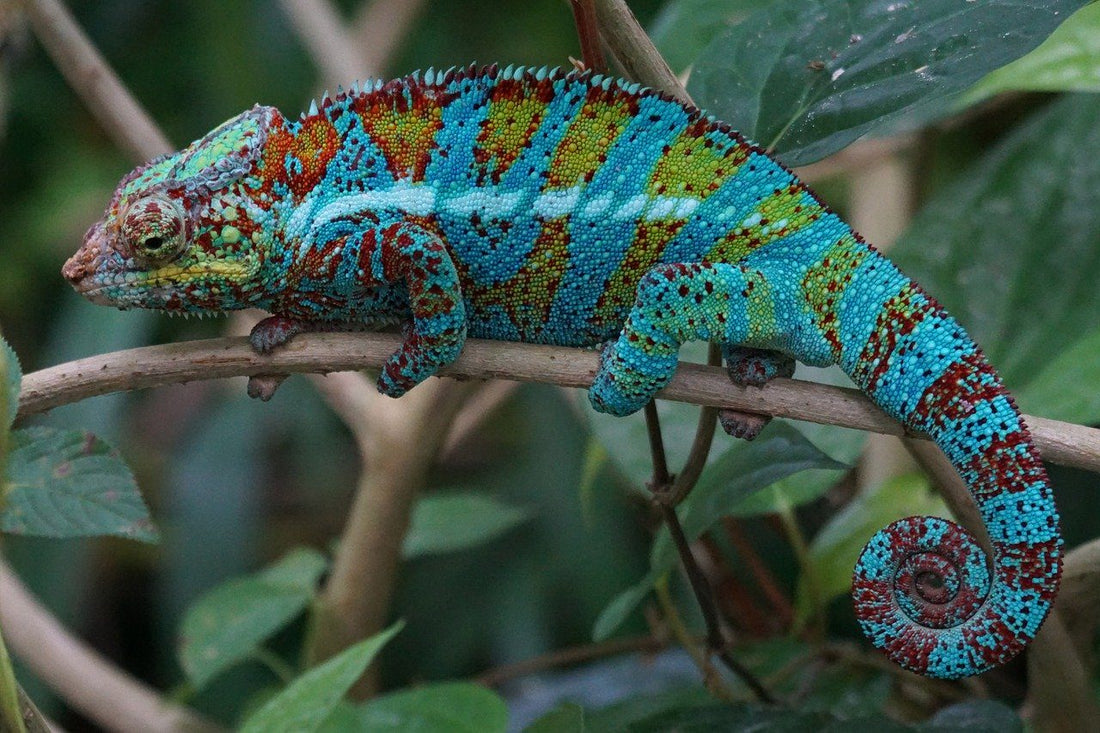
Chameleons are remarkable reptiles known for their unique ability to change colors and blend seamlessly with their surroundings. With their distinct appearance and captivating behavior, they have become popular pets for reptile enthusiasts. If you're considering a chameleon as a pet, this article will provide you with a general overview of their characteristics and care requirements.
Chameleons are for the experienced owner and cannot be over-handled.
General Description: Chameleons belong to the family Chamaeleonidae and are known for their zygodactyl feet (two toes pointing forward and two toes pointing backward), independently moving eyes, and long, prehensile tail. They come in various colors and patterns, with some species exhibiting more vibrant hues than others. Chameleons have a unique body shape, with a laterally compressed body and a casque (helmet-like structure) on their head in certain species.
Life Span: The lifespan of chameleons varies among species, but on average, they live for 5 to 10 years in captivity. With proper care and a suitable environment, some species, like the veiled chameleon (Chamaeleo calyptratus), can live up to 5 to 7 years.
Natural Habitat: Chameleons are primarily found in tropical and subtropical regions of Africa, Madagascar, southern Europe, and the Middle East. They inhabit a range of habitats, including rainforests, savannas, and even deserts. Each species has its specific requirements and adaptations to their native environment.
Average Size: The size of chameleons varies significantly among species. The smallest chameleons, such as the brookesia species, may measure only a few centimeters in length. On the other hand, larger species like the veiled chameleon can reach lengths of 12 to 24 inches (30 to 60 cm) from snout to tail.
Enclosure Size: Chameleons require spacious enclosures to accommodate their arboreal nature and provide ample climbing opportunities. The appropriate enclosure size depends on the species and the size of the chameleon. Ask our reptile specialists what size enclosure is best suited to your type of chameleon.
Temperature Requirements: Chameleons are ectothermic reptiles, meaning they rely on external heat sources to regulate their body temperature. Provide a temperature gradient within the enclosure, with a basking spot temperature ranging from 85-95°F (29-35°C) and a cooler side around 75-85°F (24-29°C). UVB lighting is essential for chameleons to metabolize calcium and maintain overall health.
Humidity Requirements: Chameleons from different regions have varying humidity requirements. Generally, a humidity level of 50-70% is suitable for most chameleon species. Misting the enclosure multiple times a day, providing live plants, and using a dripper or fogger can help maintain appropriate humidity levels.
Substrate and Bedding: Chameleons do not typically require a substrate, as they spend most of their time in the trees. However, you can consider using a natural substrate like coconut fiber or sphagnum moss in the enclosure's bottom to help with moisture retention and create a more naturalistic environment.
Toxic Substances: Chameleons have delicate skin and are sensitive to chemicals and toxins. Avoid using cleaning products, pesticides, or any toxic substances near their enclosure. Also, be cautious about using plants that may be toxic if ingested, such as pothos or philodendron. Research safe plant options for the enclosure.
Also avoid essential oils or aerosol sprays/household cleaners containing chemicals and harsh scents. Candles and scented candles or wax melts should be avoided.
Fun Facts:
- Chameleons change color not just for camouflage but also for communication, temperature regulation, and expressing emotions.
- They have exceptional eyesight, with each eye capable of moving independently and providing a 360-degree field of vision.
- Chameleons have a long, sticky tongue that they rapidly extend to capture insects and other small prey.
- Some species of chameleons, like the Jackson's chameleon, have three horns on their head, adding to their unique appearance.

Chameleons are fascinating reptiles that require specific care and attention to thrive in captivity. By providing an appropriate enclosure, temperature gradients, UVB lighting, and maintaining proper humidity levels, you can create a suitable environment for your chameleon companion to exhibit their natural behaviors and adaptations.
| https://theurbanzoo.myshopify.com/products/veiled-chameleon-spanky-bloodline |






